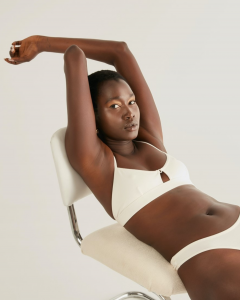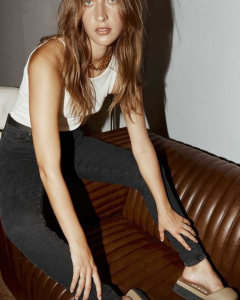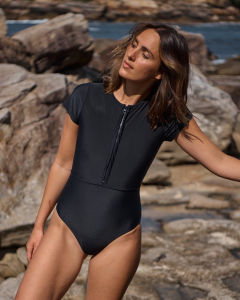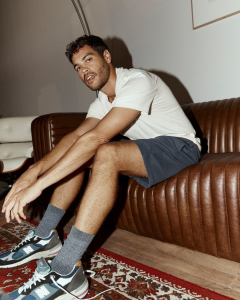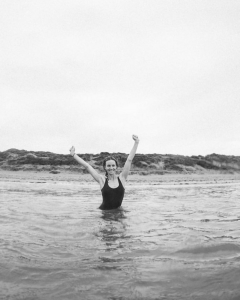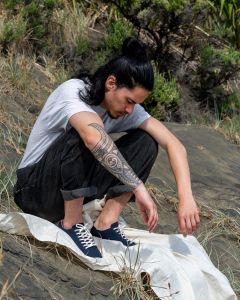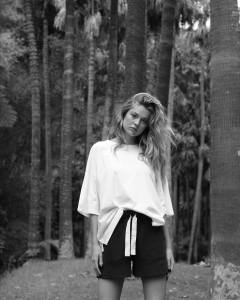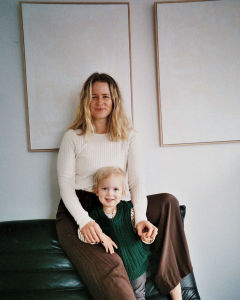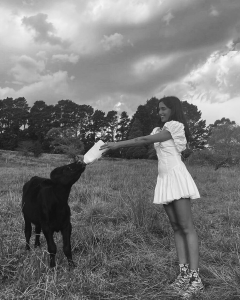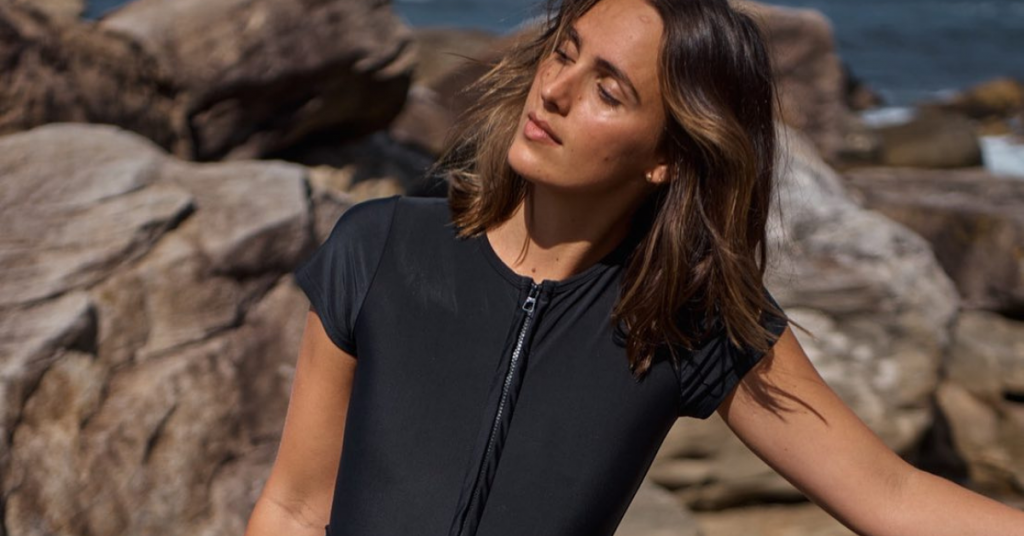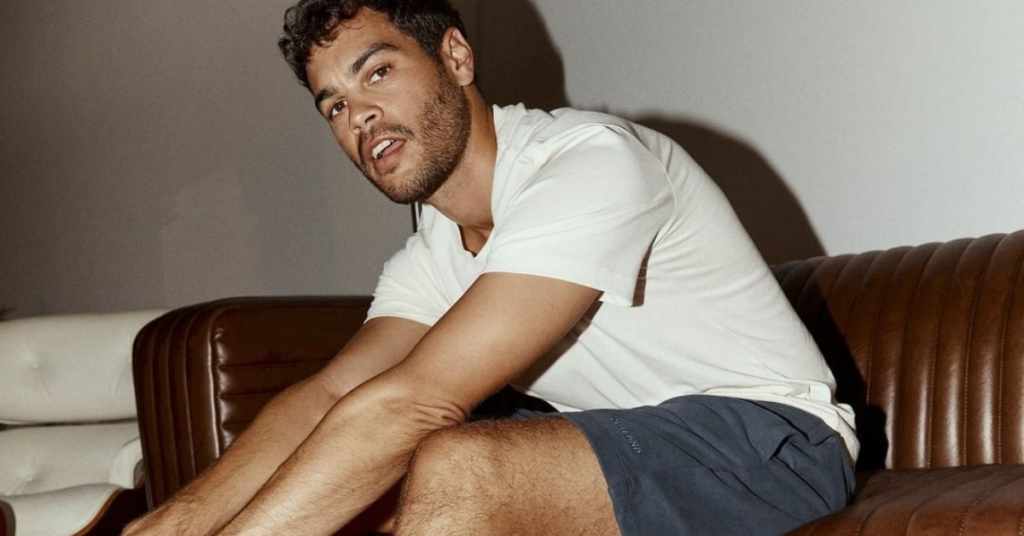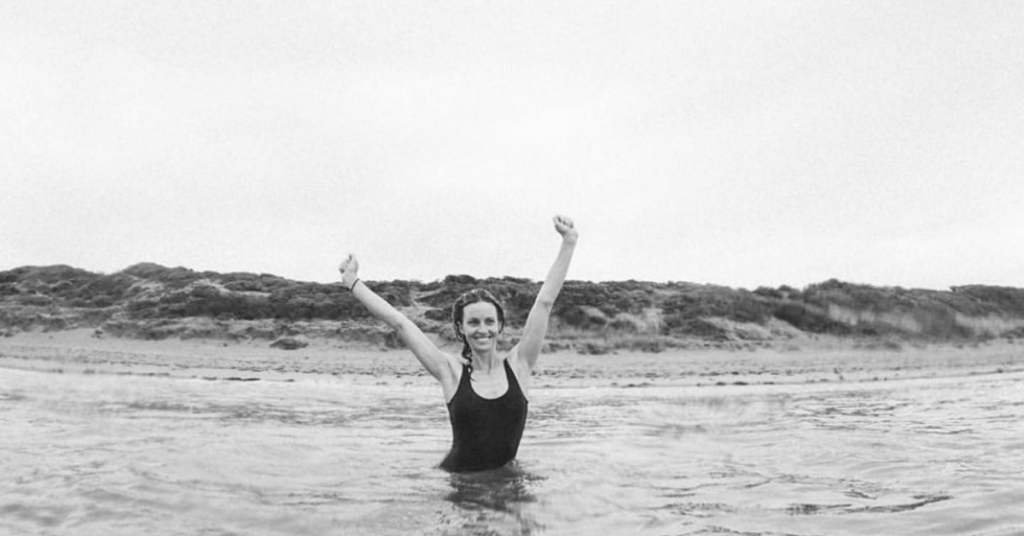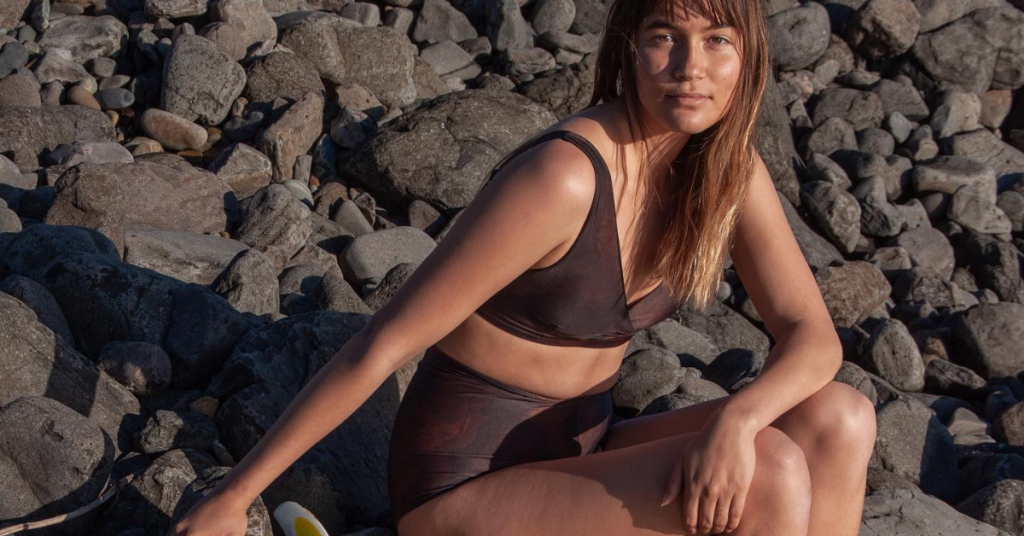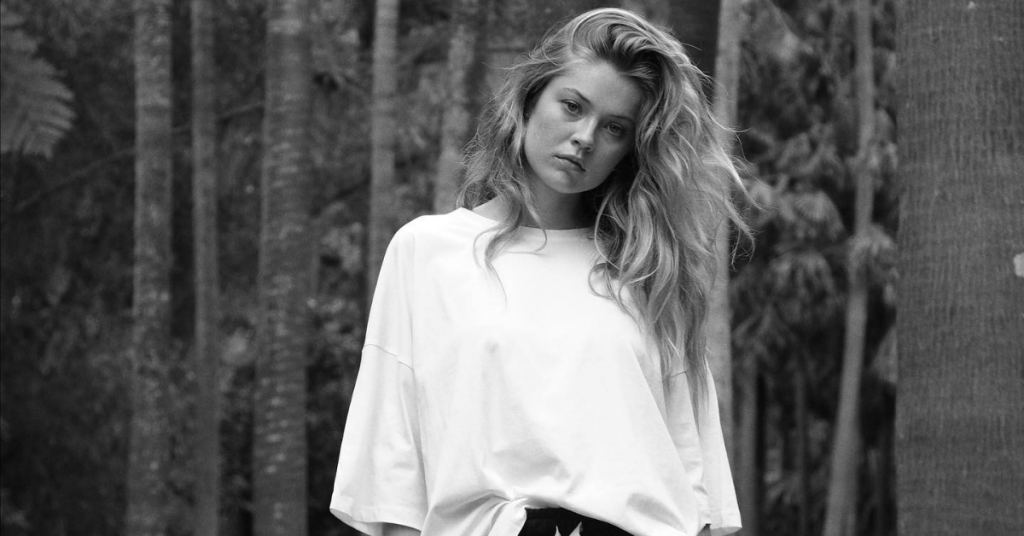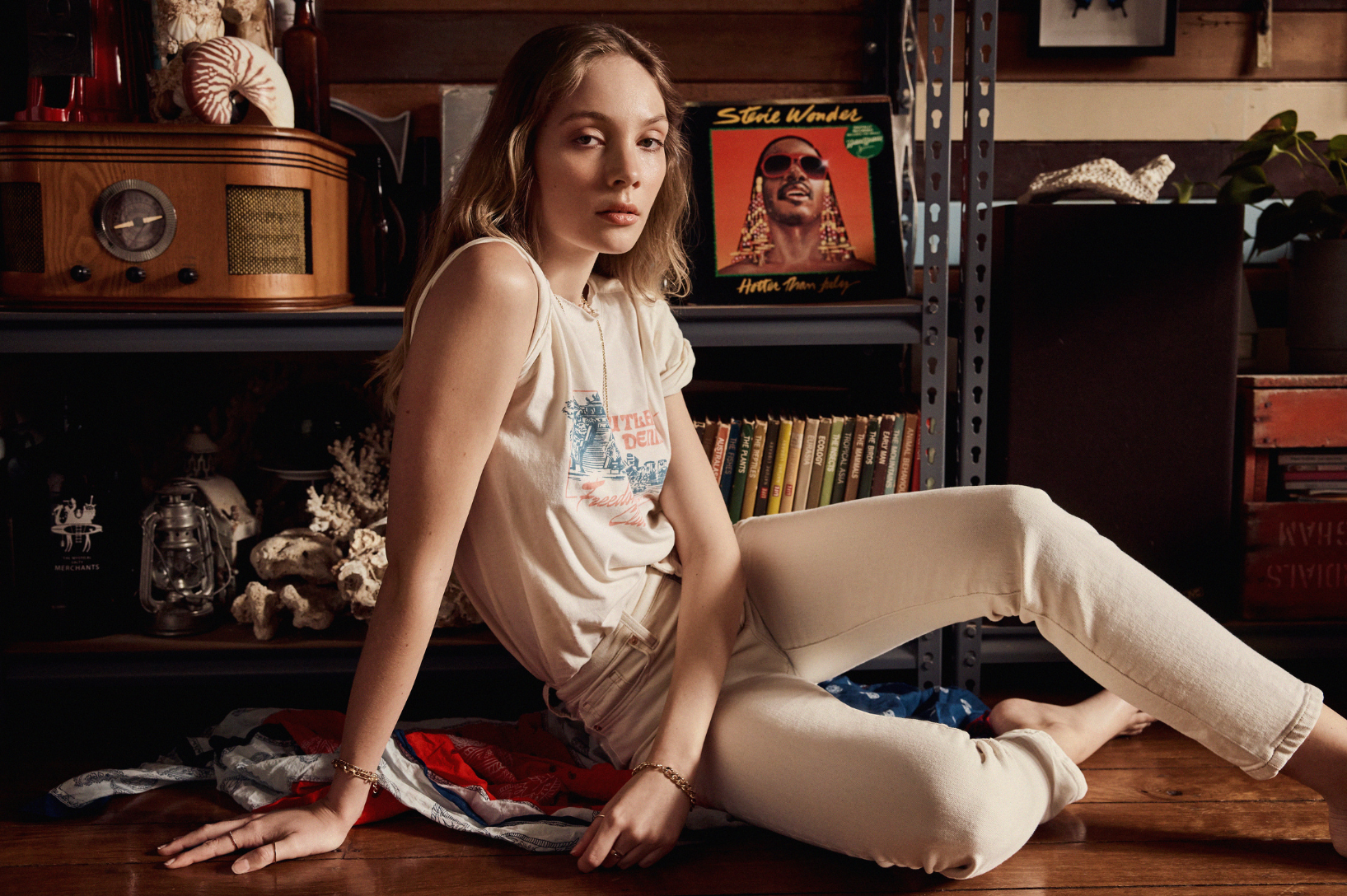There are many questions a lot of us ponder, though we know in our heart of hearts we’ll never fully know the answer to. What’s really used in hot dogs? What is the meaning of life? Why did the chicken actually cross the road? Sorry to disappoint, but no, we are no closer to finding out the answers to these questions than you are. However, when it comes to ethical fashion, sustainable fashion, and slow fashion, and which brands participate in these concepts, we can definitely help.
With this, we’ve put together a definitive guide to ethical fashion so you never have to look anywhere else for this info again. Think of it as your ethical fashion bible or cheat sheet.
Basically, it’s the only resource you’ll ever need when you have a question about the often muddy waters of ethical fashion.
Bookmark this page, print it out and stick it on your wall, or copy the URL to your stickie notes for future reference. Whatever you do, make sure you have a copy so you can come back to it every time you have an ethical fashion question.
Let’s get started.
Click the link underneath to take you straight to your specific FAQ:
Image above is of The Unseen Label, an Australian company ethically-making toxin-free, non-discriminatory underwear.
For fashion to be considered ethical, it must be produced with environmental and social responsibility. Ethical fashion brands ensure that the people who make their garments are paid fairly, and work in discrimination-free, empowering and safe environments.
What is ethical fashion?
“The general definition of ethical fashion, is fashion that aims to reduce the negative impact on people, animals, and the planet. Producing an item of clothing involves design, labour, and materials. Ethical fashion is kind to the planet and people every step of the way, from seed to garment.”
Materials
Ethical fashion considers the impact of using materials to make clothing. Linen, cotton, polyester, denim, ECONYL; each fabric has a different impact on the planet and its people, and choosing the material with the lesser environmental impact (organic cotton) or repurposing a material that is already in circulation (deadstock) is typical of ethical fashion companies.
Being able to trace the supply chain of this the material as far back as those who harvest the crops is also considered in the ethical fashion process. Outland Denim, for example, can trace their entire denim supply chain from seed to garment; they know how many farms and people are involved in producing their cotton to the wages of the workers who sew their sustainable garments.
Dyes
In China, they say you can tell the popular colour that season by the colour of the rivers.
Traditional textile dyeing methods are incredibly detrimental, both to the environment and to the people living around these dyeing facilities. Textile dyes often contain chemicals like formaldehyde (a gas that, with high exposure, can cause cancer) and heavy metals including cadmium and lead. When factories do not responsibly contain and manage dye waste, these dyes flow into waterways, contaminating the drinking and bathing water of surrounding villages. Destruction of plant life and ecosystems, as well as serious and ongoing health issues for humans, are some of the repercussions of irresponsible dye use.
Alternatively, ethical fashion focuses on more ethical and sustainable dyeing processes. Dyeing clothing with vegetable-based dyes – including indigo dyes and natural pigments from barks and roots (we see you, RUPAHAUS) – recycling and reusing dyes, ensuring dyes are part of a closed loop system and simply leaving a garment in its natural un-dyed state are all ways ethical fashion companies are colouring their garments more sustainably.
Labour
There are around 40 million garment workers in the world today, and an estimated 2% of them are paid a living wage. Growers, producers, movers, makers, packers and sellers are exploited, underpaid and put in terrible working conditions. Garment workers are often denied access to clean drinking water and regular breaks, and face abuse, harassment and forced extended working hours. It was the Rana Plaza tragedy in 2013 that forced the world to recognise the wickedness of the fashion industry but now, years later, the problems remain.
The fast fashion industry has gripped the world with its promise of never-ending trends, criminally low prices, and convenience. As a society, we have grown used to the over-production of extremely cheap clothing available at the click of a button, and the humans who make this clothing and the planet from which finite resources are being extracted have become an afterthought.
Ethical fashion companies are working to shift this mindset.
Image above is of Outland Denim, an Australian sustainable fashion company redefining what it means to do good business.
What is Sustainable Fashion?
Sustainable fashion is a bit of a complex beast, and it’s hard not to go down a rabbit hole when trying to figure it out. There’s a lot of definitions of and ideas surrounding sustainable fashion, and we believe that just like ethical living, how we both interpret and participate in sustainable fashion is different for everyone.
In saying this, we can all probably agree that the overall purpose of sustainable fashion remains the same for everybody: to shift the fashion industry towards a more environmentally responsible, a more socially just, and a more sustainable future.
To put it simply, sustainable fashion is essentially a more considered approach to both the environmental and socio-economic impact fashion has. Companies that operate under the sustainable fashion umbrella do so in an environmentally and socially responsible way, and aim to be extremely transparent both with their supply chain and their processes.
The Green Strategy has summed it up well:
“Sustainable fashion can be defined as clothing, shoes and accessories that are manufactured, marketed and used in the most sustainable manner possible, taking into account both environmental and socio-economic aspects. In practice, this implies continuous work to improve all stages of the product’s life cycle, from design, raw material production, manufacturing, transport, storage, marketing and final sale, to use, reuse, repair, remake and recycling of the product and its components.”
Sustainability in fashion means considering everyone and everything in the process through which the garments are created, from the impact the production has on our environment and the animals within it, to the people who create the garments and the consumers for which the garments are a necessity.
Image above is of Hakea Swim, an environmentally and socially responsible swimwear company making waves in the Australian fashion scene.
What is the difference between ethical, slow, and sustainable fashion?
01: Ethical fashion
Let’s start with ethical fashion.
Ethical fashion is different for everyone and is defined in varying ways, though the principles of ethical fashion remain the same: the ultimate meaning of ethical fashion is fashion that “aims to reduce the negative impact on people, animals, and the planet.”
Ethical fashion takes into consideration the rights of both the people who make the clothing and the animals from which some materials may be taken, and the environmental impacts the creation of the clothing may have on the environment.
Ultimately, our ethics are our own, and the ethics we hold with the highest regard can dictate how we participate in ethical fashion as individuals.
02: Slow fashion
Slow fashion is both a mindset and a mode of production; it is essentially a movement intended to slow down the process between the consumer’s need for clothes and the end of a garment’s life.
To understand it a little better, we need only look at its opposite: fast fashion. Whilst the core of fast fashion is to pump out as many styles as possible in as little time as possible, the intention of the slow fashion movement is for consumers to craft a relationship with the clothing they buy.
What’s more, slow fashion brands have a more considered approach to garment production, including made-to-order models and limited runs.
03: Sustainable fashion
Then there is sustainable fashion. Basically, sustainable fashion seeks to create an industry that is completely devoted to moving fashion towards a more environmentally and socially conscious future. Longevity surrounds every aspect of a forward-thinking, sustainably operating business, from its finances to its environmental features, and sustainable fashion companies are no different. To be quite frank, it is only these businesses that we have room for on this earth.
Although ethical fashion, slow fashion, and sustainable fashion each hold immense importance individually, when combined, the three are unstoppable—kind of like Destiny’s Child. If every one of the principles ruling each of these respective fashion ideals were merged to create some miracle business model, there would literally be no need for any abuse, exploitation, or sweatshops in our supply chains. Ethical, slow, and sustainable fashion may be different in their individual aspects, but the overall goal behind each remains the same.

Image above is of Lois Hazel, an Australian ethical fashion brand using deadstock and eco-friendly materials.
What is the difference between ethical fashion and fast fashion?
The question:
What is the difference between ethical fashion and fast fashion?
The answer:
One of them is worthy of your money, and the other definitely is not.
What is ethical fashion?
The general definition of ethical fashion is “fashion that aims to reduce the negative impact on people, animals, and the planet.” Producing an item of ethical clothing involves design, labour, and materials, and ethical fashion is kind to the planet and people every step of the way, from seed to garment. Ethical fashion considers the impact of using materials to make clothing, from linen and cotton to polyester and denim, as each fabric has a different impact on the environment, and choosing the lesser impact is what ethical fashion is all about.
What is fast fashion?
“Need a shirt? Buy a new one. New shirt gets a hole in it? Buy a new one.” This is basically the concept behind fast fashion. As Melinda Tually, the coordinator of Fashion Revolution, says: “you know something’s fast fashion if it’s sold in high volume with a low profit margin.” Essentially, fast fashion is known for its pace; you can bring an item from the factory to the shop in three to four weeks, and because it’s as cheap as a cup of coffee, people keep buying it in high amounts. Fast fashion jips the people who buy into it, has horrific consequences for garment workers who create it, and is a practice that is completely unsustainable on this planet.
How do ethical fashion and fast fashion differ?
The differences between ethical fashion and fast fashion essentially lie in the production processes, and also in the thought given to the lifespan of the garments. In the design stage of any ethical fashion garment, there is always thought given to that specific garments’ ability to withstand trends, its versatility and multifunctional aspect, and its durability. The fast fashion model, on the other hand, is focused upon selling the largest amount in the least amount of time, and is centred around the idea that there are 52 seasons rather than four.
There is no abuse or exploitation in ethical fashion supply chains, no sweatshops or child labour, but the same cannot be said for fast fashion. Fast fashion factory workers, most of whom are female, are exposed to multiple levels of abuse in their working lives, and according to Oxfam, just 4% of the money Australians spend on their clothing actually goes towards the wages of garment factory workers. This makes it extremely difficult, if not impossible, for these people to pull themselves out of this life, a life we wouldn’t wish upon our worst enemies.
The environmental concerns between the two fashion models differ greatly. It is a commonality within companies that operate with fast fashion processes to not actively be involved in, or turn a blind eye to, the unethical processes in which their products are made, and also to the toll the production takes on the environment. According to Oxfam, the carbon footprint of one new shirt is greater than driving a car for 35 miles, and the Elle MacArthur Foundation tells us that less than one percent of clothing material is recycled into new textiles.
There are many facets to the question we’ve been trying to answer for you, but if there’s anything we want you to take away, it’s this: if you feel passionate about doing your part to make this world a better place, then you should break up with fast fashion for good. As consumers, we can think of both ethical and fast fashion as separate ideas—one operates with people and the planet in mind, and the other with profit. We don’t know about you, but we definitely know which one we would rather believe in.
Image above is of Outland Denim, an Australian sustainable fashion company redefining what it means to do good business.
Why is the current fashion industry not sustainable?
To answer this Q, we’ve got to use the dreaded F word: fast fashion. What F word were you thinking of? Fast fashion is clothing and accessories that are made in high volumes at an incredibly fast rate to be sold with low profit margins. It’s basically the fast food version of the fashion industry. And what do we know about fast food? It can’t sustain us for very long (remember Super Size Me?).
Fast fashion is far from sustainable and relies on poor ethics and the exploitation of people, animals and the environment.
The following facts will paint a picture of just how unsustainable and unethical the industry really is. Hold onto your ethically-made hat because this may come as a bit of a shock to the system.
“It would take 12 years for H&M to use up 1000 tons of fashion waste – the amount of clothing they produce in about 48 hours.” – Lucy Siegle
“Among 71 leading retailers in the UK, 77% believe there is a likelihood of modern slavery (forced labour) occurring at some stage in their supply chains” – ethicaltrade.org
“10% of global carbon emissions come from the fashion industry, which is more than shipping and aviation combined” – Ellen Macarthur Foundation
Melinda Tually, the coordinator of Fashion Revolution Australia, says you know something’s fast fashion if it’s sold in high volume with a low profit margin.
New product comes into the store almost once a week, and (unsurprisingly), it’s known for its pace; you can bring an item from the factory to the shop in three to four weeks. And, because it’s as cheap as a cup of coffee, people keep buying it in high amounts. Fast fashion has detrimental long-term effects, both environmentally, socially, and financially, and in the grand scheme of things, is anything but sustainable.
Image above is of Zorali, a sustainable adventure-wear brand whose aim is to inspire people to get outside and explore the wonders of the natural world. Use ‘EME’ if you’d 15% off.
What makes a brand ethical?
What actually makes a brand ethical?
This is a question as old as time. Well, probably not, but it’s definitely just as complicated. Like you and your high school best friend, the terms “ethical” and “sustainable” seem to be joined at the hip, and although they intertwine and complement each other greatly, the actual meanings behind the respective words differ.
To be sustainable means to be “able to be maintained at a certain rate or level” (thank you, Google). However, to be ethical means to “relate to moral principles or the branch of knowledge dealing with these”. Basically, it’s one thing for a company to portray their ethics in all of their advertising, but it’s another for them to actually walk the moral walk a lot of them talk. We don’t know about you, but we don’t want to be catfished by a company on their ethics.
Let’s talk about the implementation of ethics in terms of ethical fashion. For “ethical” to be put in front of the word “fashion”, the company using the term must be doing everything in their power to craft a fair, ethical, transparent supply chain. Perhaps the most prominent methods of implementing ethics into their supply chain are the way in which they treat the garment workers who make their clothes. By treat we don’t just mean their treatment in the workplace, we’re talking about the whole shebang including the conditions the employees work in and, of course, the pay and benefits they receive.
The What She Makes report released by Oxfam states that, in 2016, the annual turnover in the Australian garment industry alone was $27 billion. Despite this, companies are still choosing to participate in the abuse, exploitation, and neglect of garment workers—abuse, exploitation, and neglect that came to a completely avoidable and catastrophic head in the 2013 Rana Plaza tragedy. If not working for a company for which ethics in business are a necessity, garment workers in Indonesia get paid a pathetic sixty-two cents (AUD) an hour. Considering that “just 2% of the retail price ends up in workers’ pockets”, we don’t think there’s anything ethical about that fact.
A lot of people seem to agree with us, too. More and more people are starting to—excuse our French—give a shit, about ethics and sustainability in today’s society, which is a massive step in the right direction (go us). More companies are making the move to a more ethical way of producing, though with any success comes a window of opportunity for others to mimic or take advantage of this window—need we remind you of the whole Kmart/Veja situation? Aside from plastic and Christmas albums, what is rife in this day and age is greenwashing, which is why we all need to be on the lookout for those pesky companies who say they’re something they actually are not. See: catfishing.
If a clothing company—or any company—claims to be ethical, you can be sure that that company will be as transparent as possible. Transparency can come in many different forms, and companies can show it in a few different ways. Some will publish everything on their website, others will pop up the lists of certification organisations when you type their name into Google, and a few will even go as far as releasing the lowest wage they pay their employees. If they’ve got nothing to hide they won’t hide anything, right?
So, what actually makes a brand ethical? If a company operates with ethics at the core of its operations, you can be sure they’ll want you to know about it. It’ll be on their website, it’ll be there when you type their name into Google, and it’ll probably be in our ethical brand directory. By supporting and purchasing from these forward-thinking, heart-driven companies you are helping to ensure that there remains an “ethical” in front of the word “fashion”. Keep fighting the good fight you fabulous human, ‘cause you don’t realise how big of a difference you are actually making.
Image above is of Collective Canvas, a New Zealand-based sustainable shoe company ethically producing timeless and versatile canvas sneakers.
What makes a brand sustainable?
Supply chain transparency is a big one when it comes to a brand’s sustainability credentials. When most people think of ethical fashion, they think of the clothing production stage of the supply chain being dealt with appropriately. A clean, safe, air-conditioned factory, with well-paid makers coming in for a normal 9-5 day of sewing up garments. But this is just one event in the supply-chain-of-events. Raw materials, garment manufacturing, and the wear and tear of the garment and its place at the end of its life are all considered by sustainable fashion brands.
Sustainable fashion brands consider the lifespan of a garment early on in the design stage of a garment’s life. These garments are designed to pass seamlessly through trends and seasons, and become the staples characteristic of the sustainable fashion industry. Clean lines and silhouettes, and re-wearable, enduring, and timeless designs are common features attributed to sustainable fashion pieces.
Fabrics also play a tremendously important role. Sustainable fashion brands consider the lifespan of a garment before it is even created, taking into account the strength and quality of the fabric they use and its ability to withstand the weather, the washes and, of course, the inevitable coffee stains. More often than not, these fabrics are also chosen due to their ability to be composted or to biodegrade once the wearer has no use for the garment anymore.
Moreover, sustainable fashion brands also choose the fabrics they work with based on their environmental impact, with these materials more often than not having been grown and harvested responsibly. Organic cotton, linen, and hemp (when responsibly-grown and sourced) are a few of the fabrics sustainable fashion brands tend to favour, as well as materials made from waste (including ECONYL) and also deadstock: leftover fabric that would otherwise have been sent to landfill.
Image above is of Hakea Swim, an environmentally and socially responsible swimwear company making waves in the Australian fashion scene.
Is fast fashion ethical?
The long answer: as we’ve said, the purpose of ethical fashion is to “reduce the negative impact on people, animals, and the planet.” So, although fast fashion can (and should) operate with ethical processes, it is not a practice we can sustain on this planet. In saying this, companies adhering to the fast fashion model of production do not have the right to turn a blind eye to the suffering of the people who are making their clothing, and will need to bring their business models into the twenty-first century before all of our natural resources have run out.
Ethics
The What She Makes report released by Oxfam states that, in 2016, the annual turnover in the Australian garment industry alone was $27 billion. Despite this, fast fashion companies are still choosing to participate in the abuse, exploitation, and neglect of garment workers—abuse, exploitation, and neglect that came to a completely avoidable and catastrophic head in the 2013 Rana Plaza tragedy. If not working for a company for which ethics in business are a necessity, garment workers in Indonesia get paid a pathetic sixty-two cents (AUD) an hour. Considering that “just 2% of the retail price ends up in workers’ pockets”, we don’t think there’s anything ethical about that fact.
On the other side of the spectrum is ethical fashion and, as an example, we’re going to use kickass ethical company, Dorsu. The team at Dorsu work extremely hard to provide their staff with a safe and fair working environment, and their website provides information about these employment conditions to anybody who wants to know (hello transparency). This includes permanent contracts reviewed annually, and a five day working week; base wages that exceed the Cambodian-legal minimum, monthly performance-based bonuses and optional sixth day at overtime rates during busy periods; nine hour working day, including one hour lunch and two 15 minute breaks; and annual leave accrued, main national public holidays, sick and personal leave, and maternity and paternity leave.
Sustainability
We have become a throwaway society, and this is in large part due to the rapid rate in which products are being made. Australians as a whole get rid of 6,000 kilograms of textile waste every ten minutes, and each year, over 501 million kilograms of discarded clothing ends up in landfills. Do you know what’s even scarier, though? The fact that these stats don’t even account for the 94 million kilograms of unwanted textiles that are transported overseas. It is extremely likely that the fast fashion purchases we’ve all made in our lives have either found their way into landfill or onto the ships bound for poorer countries after we’ve worn the garments only a handful of times, if at all.
Garment manufacturing is one of the most environmentally destructive industries on the planet and this is why ethical fashion companies do everything in their power to consider their garments places in a closed loop system, and to minimise the amount of waste they send to landfill (if they send any at all). Using leftover fabric to make accessories or postage bags, creating “take back” systems in which clothing can be sent back and used for other purposes, and ensuring the materials used have been produced in a sustainable way are just a few of the ways in which these companies are abiding by the ethical fashion criteria.
Image above is of Outland Denim, an Australian sustainable fashion company redefining what it means to do good business.
Image above is of Cloth & Co., an Australian fashion company ethically and sustainably crafting comfortable, versatile and timeless basics from organic cotton.
What fashion brands are ethical?
As we all know by now, ethical fashion is a term used to define companies that operate with ethical processes. But what makes a brand ethical? The criteria includes fair trade and sustainable manufacturing, and does not include abuse or exploitation of any kind at any stages within the supply chain. More often than not, ethical fashion companies find ways to give back to the community, or to support a charity or an organisation that is doing immense environmental or social good. You all probably know by now (sorry for the preaching), but ethical fashion is the only kind of fashion we want.
Take Outland Denim, for example. Not only do the Outland Denim team ethically make stylish, high-quality jeans, but they’re also tackling an industry that may seem quite distant to us: the sex industry. They’re using their business to properly equip victims rescued from the industry with tools that will serve them for the rest of their lives with the “Denim Project”: a project with an aim to enable and empower these rehabilitated girls who have shown an interest in sewing.
If you’ve been trying to make positive changes in your purchasing habits (and kudos to you if you have!), we are here to make your life a little easier in that department. Essentially, if a company is transparent with their eco-friendly processes, their fair working conditions, the traceability of their products, and the amount of wastage they’re creating, then you may have found the ethical company you’ve been looking for. This is just a rule of thumb, though; be sure to do your own research if you have doubts, ’cause some companies are experts at the greenwashing game.
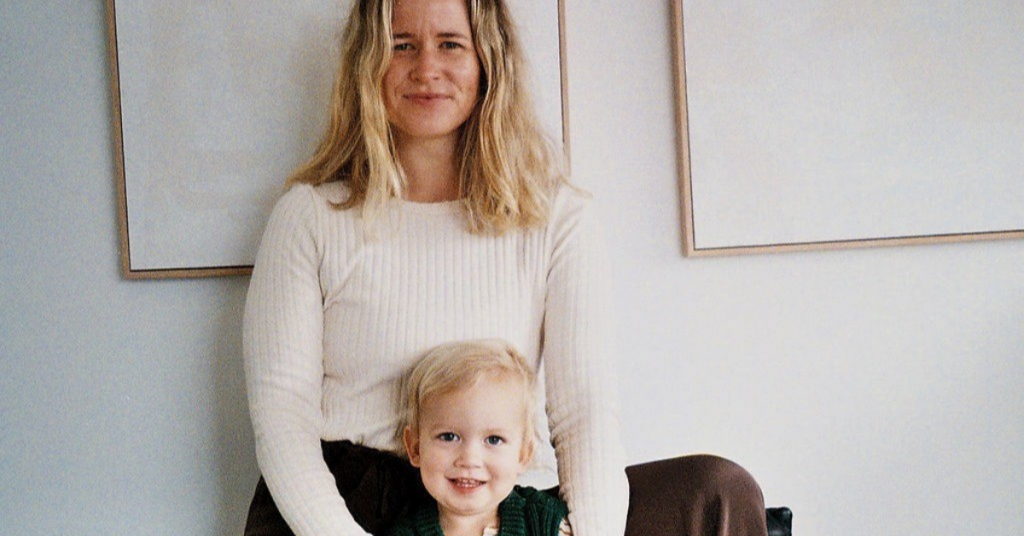
Image above is of Abbylee Bonny in Lois Hazel, an Australian ethical fashion brand using deadstock and eco-friendly materials.
Why is ethical fashion important?
Ethical fashion is important because the mode of consumption we have become used to is completely unsustainable. The long term effects be absolutely detrimental to the health of the planet and the people on it, and we’re already seeing just how bad they can be.
Environment
According to The True Cost, the world’s population is consuming 400% more clothing than it was at the start of the millenium, cotton production is responsible for 18% of the world’s pesticide use and 25% of its insecticide use, and the amount of resources used to raise cattle for leather production is dramatically impacting the health of our planet. The production of fast fashion contaminates all forms of water bodies, and “is responsible for producing 20% of global wastewater”; and 97% of fast fashion garments are produced overseas, with emphasis on poor countries (thank you for this info, 7Billion for 7Seas). These are just a few of the reasons why ethical fashion is important.
Garment workers
On the 24th of April 2013, the Dhaka garment factory collapse, otherwise known as the Rana Plaza tragedy, occurred in Bangladesh. The structure that contained clothing factories and other businesses collapsed, killing 1,134 people. More than half of these people were women, and this number also includes children who were being cared for whilst their mothers were working in the factory. Cracks were discovered in the building the day before the collapse, but the owner of the building ignored warnings to discontinue using it, forcing garment workers to resume business as normal.
This tragic event should never have taken place, and serves as a cruel reminder as to just how important ethical production is. Fast fashion is responsible for the abuse and exploitation of not only the planet’s natural resources, but also the people who make our clothing. Garment workers, 80% of whom are women, are subjected to every form of abuse, as well as unsafe and unfair working conditions, and the Rana Plaza tragedy is just one of the many examples of why ethics in fashion matters.
You
We all know that the skin is our largest organ. We’re so careful with, and spend hundreds on the products we put onto our skin, though there is something that does not make sense. What we seem to be forgetting is that the clothes we’ve purchased from our favourite fast fashion boutiques were soaked with chemicals at every stage of their production, and have ended up on our bodies. That’s just some food for thought.
From both a social and environmental viewpoint, ethical fashion is the only fashion model that should exist on this planet. We should bother with ethical fashion because we’re human. We should bother with ethical fashion because we want to continue existing on this beautiful planet. The rate at which we’re using resources isn’t sustainable for mother earth. We should bother with ethical fashion, because “there is no beauty in the finest cloth if it makes hunger and unhappiness.”
Image above is of The Unseen Label, an Australian company ethically-making toxin-free, non-discriminatory underwear.
Why is ethical fashion expensive?
Ethical fashion is more expensive because of the process it went through in order to get to our cupboards, and we believe any ethically-made garments should be viewed as an investment – it will continue to serve you long after the first wear. When you pay for an ethically and sustainably made piece of clothing, you are investing in each individual time you will wear it, a concept called “cost per wear”.
Cost per wear describes the price you pay for a garment, divided by the amount of times you wear it. For example, if you buy a garment for $100, and wear it 4 times, that garment cost you $25 each time you wore it. So, if you end up wearing this item once a week, in one year you will bring the cost per wear right down to $1.92307692308—less than half of the price of your daily coffee.
More often than not, the cost of a piece of clothing made within ethical processes is reflective of the money spent. As an example (and a kickass one at that), let’s take a look at ReCreate Clothing. All of ReCreate’s clothing is ethically made in their sewing centre in Dey Tmey, Cambodia, and the garment workers who create their clothing receive: a living wage with the opportunity to earn matched savings every month; a 32 hour work week to ensure plenty of time for family and life outside of work; full sewing training covering every step of the garment making process; additional training in areas such as money management, basic healthcare, reading and writing; paid holiday leave, sick leave, maternity care and overtime pay; the opportunity to care for younger children on site or support to send older children to school; and a well-ventilated, light and beautiful working environment. Gah, that was a mouthful.
Aside from the fact that all of their pieces are ethically made by well-paid, fairly treated sewers, ReCreate also ensures their fabrics are Global Organic Textile Standard (GOTS) certified, and that their denim is sourced through the Better Cotton Initiative (BCI). The shipping bags they use are 100% recyclable, reusable and biodegradable, they use a carbon neutral shipping service to import their garments, and 100% of their profits are dedicated towards community projects and initiatives. This is why you’ll not often find any of their clothing ducking below the $80 mark, but this is also why their workers live happy, safe lives, and why ReCreate Clothing will always have a place in our ethical brand directory.
However, in saying this, the price of an item of clothing is not necessarily indicative of the ethical way in which it was produced. The mark-up by brands we associate as “designer” or “luxury” is astronomical and, as the Clean Clothes Campaign report tells us, is not always a direct reflection of the quality of the product, nor the standards by which it was made. When aiming fire at companies that exploit people for cheap labour, Asia is usually the country focused upon. We all know there is complete truth in this, though what most of us are unaware of us that, according to The Clean Clothes Campaign report, the largest gap between living and minimum wages paid falls largely onto Europe. Yep, Europe. A lot of these designer brands take pride in the fact that their products are made in these European countries, including France and Italy—countries we as consumers have come to associate with “high end” products. It’s seeming as though high end and high wages do not necessarily go hand in hand.
The mark-up of products made under the name of a certain designer brand is also due to just that: the name. If a company has been kicking for a while and has established and cemented their brand as luxury within society then it could be the luxury aspect we pay for. Exclusivity is also another massive factor as to why a higher price point does not mean ethical and sustainable production. Rather than discounting the price or donating the goods, some of these companies go as far as incinerating unsold goods so those who cannot afford them at the retail price cannot access them. As is similar with most companies driven by trends, this “exclusive” mentality is what keeps the price high, and there is often no thought given to the end stage of a product’s life or its place in a closed loop system.
Moral of the story: ethical fashion is expensive because every care imaginable, from the kind of materials used to the wage the garment workers were paid to create the garments, is taken into account. The whole concept behind ethical fashion is so all garments that fit into the category will last a heck of a lot longer than any fast fashion imitations, whilst retaining their signature element of timelessness. In saying this, don’t be fooled; just because an item is expensive does not mean it was produced ethically. Make sure you check the transparency of the company, from its environmental impact to the traceability of its materials, if you’re unsure of its ethical merit. Oh, and use us, too!
Why is sustainable fashion so expensive?
Most garments made by sustainable fashion brands are generally more expensive than their fast fashion counterparts on first purchase. More often than not the price tag reflects every aspect of the garment’s life, including the labour from the workers who made it to the cost of sourcing the material. For example, a pair of Outland Denim jeans will set you back around the $200 mark, but you can be damn sure that the workers who made those jeans were paid a living wage and created them in a happy, safe environment, and those jeans will last you a very long time (EME tried and tested and still going strong four years later). It is also due to the fact that these pieces of clothing are made to last – the material is chosen because of its strength, durability, and its ability to biodegrade.
Sustainable fashion is expensive initially. When considering the cost-per-wear (CPW) of an item of clothing, the price point is more digestible. In its most basic form, the CPW describes the price you pay for a garment, divided by the number of times you wear it.
For example, if you bought a garment for $100, and wore it 4 times, that garment cost you $25 each time you wore it. Considering that fast fashion is trend-driven (and trends these days are changing more than our high school crushes did), fast fashion garments are essentially designed only to be worn until the next trend comes out. If you’re paying $60 for a dress from Zara and you wear it twice, that’s a CPW of $30. However, if you invest $200 in a piece designed to be durable, long-lasting, and timeless, over time you will get the CPW of this particular garment down to less than the price of a coffee.
But like we’ve said, sustainable fashion is a complex beast, and there are exceptions to this. Don’t be fooled: a higher price point does not always mean that a garment has been ethically and sustainably made. The mark-up of brands we associate as “designer” or “luxury” is astronomical and is not always a direct reflection of the quality of the product, nor the standards by which it was made. A lot of the time the high price point is simply due to the name, reputation, exclusivity and trends associated with that brand. So if you come across a $600 belt made by a well-known luxury fashion brand, don’t be fooled into thinking you are making an ethical decision.
Image above is of Beije, an Australian sustainable fashion brand consciously producing “luxury wardrobe essentials for the modern woman”. Each of the exquisite BEIJE garments is ethically made in small quantities by talented artisans; is crafted from eco-friendly materials, including GOTS certified organic cotton; and is designed with longevity in mind, as well as to defy seasons and trends in order to remain a timeless wardrobe staple.
How can I shop ethically?
Seriously, though, we know how daunting it can be to purchase well when you first start out on your journey to ethical enlightenment, and we want to make it as easy and stress-free as possible for you.
Step #1: Break up with fast fashion.
Breakups are tough, but when you know something is wrong then that something has got to change. Just like with an unwanted cyber admirer, the first thing you can do to ghost fast fashion is to stop all correspondence. Yep, this means unfollowing their Instagram accounts and hitting that “unsubscribe” button we’ve all come to know and love. The constant promotion of cheaply-made clothing that fills our social media feeds and inflates our email inboxes has made mindful consuming harder, and cutting off that problem from its source is the best way to combat it.
The next actionable step you can take to wean yourself off of your dependency on fast fashion is to wait. We know, we know, this is about as fun as doing a yoga class when you’ve got a huge presentation to give straight after, but slowing down the process between seeing and buying is crucial to coming down from your fast fashion high. By waiting to decide whether you actually need that shirt you know in your heart will be added to the dark abyss of your wardrobe, you’re slowing down the process—a process designed for and dictated by you, the consumer—and buying items of clothing that will most probably become the most worn, most taken-care-of pieces in your wardrobe.
Step #2: Learn how to purchase (or not purchase) well.
Refuse, repair, reuse, shop ethically and sustainably, and respect your purchases. Refuse, repair, reuse, shop ethically and sustainably, and respect your purchases. Refuse, repair, reuse, shop ethically and sustainably, and respect your purchases. This, friends, is your new purchasing mantra. If you’re wanting to make positive, lasting changes in your purchasing habits, then these five things will be your Holy Grail in the Department of Ethical Purchasing.
Refuse to buy. Unless absolutely necessary, don’t give into temptation, no matter how convenient, how easy, or how tasty that $30 faux silk skirt looks on the silver platter.
Repair what you already own. If you continue to repair your clothes, you won’t have a constant need to purchase new. Also, get crafty! If you’re a wiz with a sewing machine, make new creations with your old clothes. Who knows, you may just become the next Coco Chanel (the ethical version, of course).
Reuse. You know the saying: “I have nothing to wear!”? Yeah, throw it out the window. If you’ve got clothes in your wardrobe, you’ve got clothes to wear. Pair pieces together to create new outfits. Dig up old clothes you haven’t worn in a couple of years. If you’re a person who likes a challenge, you’ll love this one.
Shop ethically and sustainably. Although this is what we’re helping to teach you to do now, it is pretty straightforward, and once you’ve gotten the hang of it, your bank account, the earth, and the garment workers who create your ethical clothing will be extremely thankful.
Respect your purchases. Take care of your clothes. You wouldn’t buy a new fish, take care of it for a day, then not clean its bowl ever again, would you? Well, the same goes for the clothes you pay for with your own hard-earned money (apart from the bowl cleaning, of course).
Step #3: Know where to shop.
This is where we step in *insert awkward laughter here*. When you’re ready to begin purchasing ethically, visit our ethical brand directory. Not to toot our own horn, but we’ve done the research, we’ve asked the questions, we’ve tried the products, all so you don’t have to, and so you don’t give your money to a company that doesn’t deserve it. If we cut off the demand for fast fashion, we cut off the supply, so knowing where to shop is arguably one of the most powerful actions you as a consumer can do.
Image above is of The Unseen Label, an Australian company ethically-making toxin-free, non-discriminatory underwear.
How can I shop more sustainably?
The most sustainable wardrobe you could ever have is the one you already own, and the most sustainable purchase you could possibly make is to not purchase at all. We know this doesn’t sound very fun, but aside from being the most sustainable option, this is also the cheapest. Properly caring for your garments, as well as mending if and when you can, are also great ways you can participate in sustainable fashion.
When you do need to buy—because, let’s face it, it’s inevitable—our Ethical Brand Directory exist exactly for this reason: to make it easier for consumers to shop in a way that is more aligned with their ethics and values. Who woulda thought! Ethical and sustainable fashion is our bread and butter, but what you’ll also find on both of those platforms is a range of accessories and homewares—all made ethically and sustainably, of course. And all setting Tomorrow’s Standard.
Reacquainting yourself with your wardrobe; selling what you don’t wear; thrifting and buying second-hand; being a savvy ethical budgeter and keeping an eye on our Journal are just a few ways in which you can participate in ethical and sustainable fashion if you’re seriously pinching your pennies. Trust us, we’ve been there.
We’re not naive to the fact that ethical and sustainable fashion can often be on the more exxy side. Being able to participate in sustainable fashion is a privilege, though it’s one we feel that if you can afford to partake in, it’s important that you do. And it’s also precisely why we have created a Discounts page. We want all consumers—regardless of budget, taste, style, or situation—to have access to ethical and sustainable fashion, and to companies that are committed to these concepts. If you want to take it one step further, you can even email your favourite fast fashion companies to both ask them about their commitment to ethics and sustainability—if they even are committed in the first place—or just go cold turkey and boycott the worst of them.
Image above is of Selfe Studios, an Australian slow fashion label producing mindful essentials and ready-to-wear luxury lifestyle garments for the modern day woman. Use the code ‘EME’ for 15% off all full-priced items.
Can I buy ethical fashion on a budget?
Can you ever! We have an entire article dedicated to helping you start an ethical wardrobe on a budget, as well as one explaining how you can participate in ethical fashion when you’re short on pennies, and to be honest, our entire Journal is dedicated to living a more ethical life. But here’s some tips on how to buy ethical fashion on a budget, direct from us to you:
01 – Rent and swap
Renting may well be the future of fashion. We’re happy to stay in a stranger’s house (Air BnB), jump in other people’s cars (Uber), and even do other people’s dirty work (Airtasker), and now we’re all finally warming up to the idea of wearing someone else’s clothes. Hallelujah! Renting outfits gives you the thrilling experience of wearing something new, minus the part where you fork out of several hundreds of dollars for the one outfit.The compliments on wearing something new and “expensive looking” will also still flood in, and the fact that you don’t even own that outfit is like an exciting secret (cheap thrills, right?).
Swapping clothes at clothes swaps or with friends is another way to participate in a happier fashion future, too. We must remember that ethical fashion doesn’t just refer to how the garment is made; it embodies the idea that clothes are made to last, that clothes are loved, and that clothes don’t have to end up in landfill. Swapping clothes with friends or attending formal clothes swaps gives old clothes new lives and creates fresh happiness from fresh wearers, and prolongs the life of each piece of swapped clothing.
02 – Buy secondhand
Besides through Ethical Made Easy, there is no better way to connect with like minded individuals than by buying unwanted clothes at discounted prices, right? Depop, Facebook Marketplace (and similar Facebook groups), and even the odd Instagram page are just a few of the places you and your secondhand, op shopping inclined debit card can go. So, if you’re in need of a new(ish) something something, head down to your local op shop or hit up your closest Suitcase Rummage. Who knows, you may even score yourself a vintage handbag worth more than your yearly wage.
03 – Repair
This is absolutely one of the best things you can do to ensure your wardrobe remains an ethical and sustainable one, and also that your bank account remains happy. By repairing and restoring your old clothes—filling any holes, fixing any rips, and immediately working your magic on stains—you are simultaneously saving money and keeping unnecessary waste out of landfills. There’s honestly nothing more rewarding than giving some tender loving care to the clothes that are looking a bit worse for wear (literally), and if you’ve tried and failed with needles and thread, take it to a professional as a last resort. Or Grandma. Take it to Grandma.
04 – Use Us
If you do need to buy something new—because, let’s face it, it’s inevitable—or if you have been slowly saving your pennies for something to wear to all the events you’ve got coming up, then consider having a squiz at our ethical brand directory (and our discounts page) to purchase with your own values. More often than not, the companies you will be purchasing from give a portion of their own profits to a charity or an organisation that is doing immense environmental and/or social good. You can literally—sorry, forgive the millennial lingo—be donating to or financially supporting a cause without directly giving to it, and you’ll be getting something you want in return (as well as feeling the gratification of knowing you’ve given your money to a worthy cause).
Image above is of MASINI, an Australian-based sustainable sleepwear, loungewear and bedding company.
How else can I engage in ethical fashion?
01 – Read all the things
By read, we also mean listen (because audiobooks and podcasts, right?). The Resources page on our website is a fantastic way to stock up on all things ethical fashion. In it, we provide you with the run down on everything from documentaries to watch, to email templates you can fill in and send off to your favourite fast fashion companies. We basically do all the digging so you don’t have to. Not only is this an incredible way to educate yourself on all aspects of what it means to live an ethical life, but you’ll also have facts and figures ready to G O when somebody tries to tear you and your kickass ways down.
02 – Purchase well
The first step to making a good purchase is to not purchase at all, but if you do need to buy, look at what you already have. Also, instead of buying something new when an item breaks, explore ways you can repair it. The way you care for a garment or product throughout its life can have more impact on the planet than it did when it was being made. Treat every item you own like the investment that it is. This mentality will reduce the amount of waste sent to landfill, plus a fix up often costs less than a brand new item, too!
Here’s something for you to ponder: why buy something new when it already exists? Secondhand shopping and clothes swapping are great ways to promote a circular economy, and they’re better on the environment and also on your pocket (love that for us). Plus, anyone can buy a dress from H&M, but no one can replicate the stunning vintage dress you found in that hole-in-the-wall second-hand shop in Venice.
If you’ve assessed how you can avoid the purchase, look into how you can repair and reuse, and if you don’t have any luck, you’re onto the next step: making a conscious and good purchase. By this, we mean seeking out products that are made with respect for people and the planet, and looking out for natural fibres, ethical fashion certifications, transparency reports, and information about how the product was made.
You can also make a badass ethical purchase by aligning your values with a brand. Pick and choose who you want to support (e.g. if you’re a passionate vegan, or push for female empowerment, find a brand who has the same values), and keep your eye open for brands who give back to their local and global communities through other initiatives, and don’t be afraid to ask questions. We repeat: do not be afraid to ask questions.
03 – Email brands
Whether you buy from them all the time or you want to give them a good old fashioned cyber kick up the ass, write a strong-willed email to your fashion company of choice. If you’re passionate about ethical fashion, but cannot “vote with your pocket” to show your support in a positive fashion industry, this is an extremely easy and important way you can make change at a deeper level.
Email mainstream brands you wish you could buy from, but that don’t (yet!) align with your values. Ask them where their clothes are made and who makes them. Enquire about their worker’s rights, treatment, and workplace standards. If the answer is not what you would’ve liked to hear, or if the answer doesn’t come at all, then politely ask them to change their ways (trust us, swearing doesn’t usually help the cause). If we, the consumers, team up to demand positive change, they’re more likely to listen to us.
04 – Boycott the big guys
Ethical fashion is not black and white. Manufacturing and supply chains are complex and messy. For this reason, it’s possible for us to shop at the best of the worst, and support those who are making conscious changes to do better.
Especially if you are new to the world of ethical fashion, we recommend downloading the World Baptist Aid Ethical Fashion Guide. This guide rates the mainstream brands you find in your local shopping mall. It serves as a simple tool to avoid brands like Max who received a D+, and instead shop at Trenery who received an A-. This should not be your sole answer to participating in ethical fashion, but it’s the best way to begin without becoming too overwhelmed. Use this as your “gateway drug” to ethical fashion, and carry out your own research whenever possible.
Purchasing the most beautiful handmade, organic linen dresses is not the only way to change the fashion industry. It’s important that we embrace the circular economy of renting clothes, contact brands directly to let them know we demand better, and spend our dollars on companies making conscious efforts to change.
That was a lot of words, can you sum it up for me, please?
Perhaps the biggest common factor connecting the companies operating with sustainable processes is the care and concern they show towards the people who make their clothing, and the way in which their materials have been extracted from the environment. These progressive businesses know that in order to be sustainable they must ensure their garment workers are taken care of by being paid fairly, and also that they are provided with every basic human right (food, shelter, healthcare, appropriate levels of leave, and education). These companies are also extremely aware of the damaging impact the modern fashion industry has, and is continuing to have, on the environment and its ecosystems.
We’d like to point out that although there’s some absolutely incredible companies doing everything they can to provide consumers with more environmentally friendly alternatives to the modern fast fashion model, there is no such thing as a 100% sustainable company. It’s just not possible when you’re producing something. What there is an abundance of, however, is forward-thinking businesses doing everything in their power to operate with environmental and social responsibility, and also to set Tomorrow’s Standard in what it means to do good business. We have a whole bunch of them on our Ethical Brand Directory.
The most sustainable thing we could all do would be to not exist at all, but that’s obviously just not ever going to be a thing (we hope), so the second best thing we can do is to spend our money wisely and support those businesses that are putting systems in place in order to sustainably exist on this planet AND use our voices to sign petitions and be activists. We’ve said it multiple times and we’ll say it till the cows come home: we all vote with our wallets for the kind of world we want to live in, so we should all participate in sustainable fashion – however this looks for each of us. It’s about doing the best we can, where we are, with what we have available to us.
Disclaimer: We acknowledge our privilege, and we also acknowledge that, for a lot of people, purchasing sustainable fashion is just not a viable option financially. We completely understand. This is why we push the importance of doing what you can with what you’ve got. There are plenty of free or cheap things we can all do to ask for a more just fashion industry, including: writing to fast fashion brands (which we’ve made easy with our email template); watching documentaries; reading books and articles; and keeping up with some incredible people who align with our own personal ethics and values.


